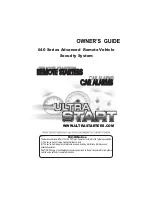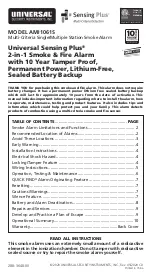
4
GB
• Ensure that smoke detectors are easily accessible for test and maintenance
purposes.
• Do not install them in rooms with high air humidity (shower rooms, bathrooms,
kitchens or utility rooms), in rooms with high temperature fluctuations (> +50°
or < +0°C) or in rooms in which the detectors may become contaminated by
vehicle emissions, dust and dirt (garages, boiler rooms, etc.). Use a heat detec-
tor here if necessary.
• Do not install smoke detectors on the ceilings of mobile homes, caravans or
similar spaces. In mobile homes and caravans, the smoke detector should be
installed on internal panels (walls) in order to avoid a thermal barrier, which
can build up under ceilings. The sun’s rays heat the ceiling and the air in the
upper part of the space. Hot air under the ceiling can prevent the smoke of a
dangerous, smouldering fire from reaching the smoke detector; therefore place
your smoke detector on the wall of the mobile home, caravan or similar space.
Basic principles of an escape plan
Draw up a floor plan which includes all doors and windows, and at least two
escape routes from each room. Windows on the first floor may require a rope or
ladder. Hold a family meeting to discuss the escape plan and tell everyone what
they need to do in the event of a fire. Specify a location outside of your house
as a meeting point in the event of a fire. Familiarise everyone in your household
with the noise of the smoke alarm system and ask that they all leave the house
if they hear this noise. Identify children’s bedrooms with a red sticker in the top
left corner of the window pane. These stickers are available from your local fire
service.
Hold a fire drill every 6 months as a minimum. Such drills help you test your
escape plan before you need to use it in an emergency. It may be that you can-
not reach your children on time. It is therefore important that your children know
what to do.
What to do when an alarm sounds
Leave the house as specified in your escape plan. Every second counts, so do
not waste any time getting dressed or taking objects of value. When leaving the
building, do not open any door without first checking its surface. If it is hot, or if
you see smoke coming in under the door, do not open it!
Use an alternative escape route instead. If the surface of the door is cool, press
your shoulder against it and open the door slightly. Be prepared to shut it again
if you encounter heat or smoke. Keep close to the floor if there is smoke in the
room. Breathe through a damp cloth if possible. As soon as you are outside, go
immediately to your agreed assembly point. Check that everyone is present. A
list of individuals will help. When you are outside, call the fire service using your
mobile phone or a neighbour’s telephone. Do not go back into the house until the
fire service gives you permission.
False alarm
A false alarm can, for example, be triggered by the following circumstances:




























